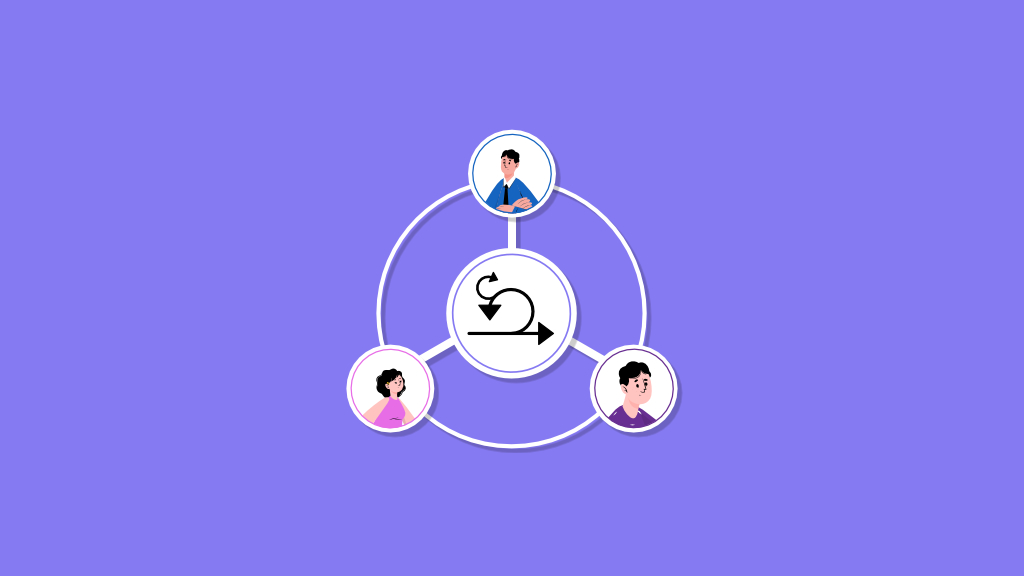A regular team is a group of people working together to achieve a shared set of goals, right? But, how is an agile team different from a regular team? Do agile teams have some special skills that make them distinct from other teams?
I know, these are some questions echoing in your head and all you need right now are some sensible answers – that’s probably why you are here.
Through this article, I will share all the vital information that you need to become familiar with Agile Teams and how they work in a professional setting.
Additionally, I will also share some proven tips to build a winning agile team for your business or organization.
What is an Agile team?
An agile team is a group of specialized professionals having the right knowledge and experience required for executing projects using the agile methodology.
Usually, an agile team has all the essential resources required to finish projects. They don’t have to rely on collaborating with other teams to get their work done. The members of an agile team have everything they need to carry out different phases of a project, including the creation of work breakdown structure (WBS), working on tasks, testing, deployment, and project closure.
As the word ‘agile’ suggests, teams that follow agile principles can execute projects faster along with improving the quality of the overall deliverables. As agile teams work only on one project at a time, they enjoy a better understanding of the project objectives and maintain high levels of productivity.
Introduction to Agile project management methodology
Learning about agile teams is pretty much incomplete without having at least some idea about the agile methodology in project management. So, I think that before we move further, you should get a little idea of what Agile project management is all about.
In general, agile project management is an approach in which the whole project is divided into multiple stages with a focus on using iterations for refining work until the desired quality is achieved. Teams following the agile methodology work in coordination with stakeholders and clients for continuous improvement of deliverables quality.
Agile methodology is mostly used for handling projects that have dynamic or changing requirements. With Agile project management, development teams and businesses ensure that the needs of customers are met most effectively.
Talking about the applications and scope of Agile project management, it is mainly used for software development projects, and there’s a reason for it. Actually, the agile methodology was developed to fill the voids in other traditional methods used in the software industry, such as Waterfall, Scrum, rapid application development (RAD), etc.
However, in the past few years, Agile project management has set its foot in other industries like event planning, construction, finance, aerospace, and pharmaceutical.
What are the key roles in an Agile team?
Typically, there are 4 key agile team roles – Product owner/client, Scrum master/team leader, development team, and stakeholders.
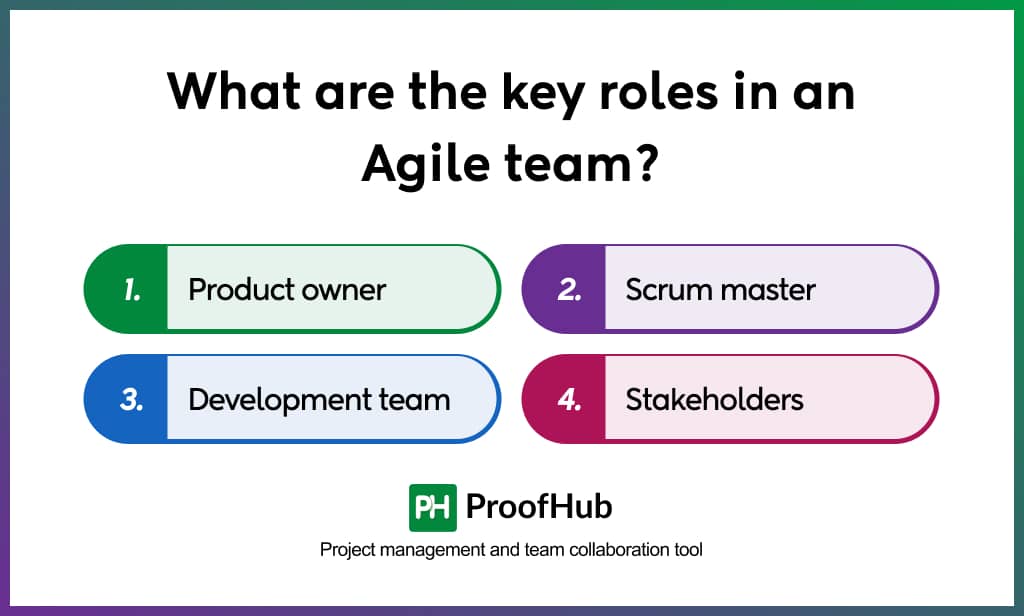
1. Product Owner
The responsibility of the product owner is to communicate the product requirements of stakeholders with the team. They also have the authority to make changes to the project scope.
2. Scrum master/Team leader
The scrum master is responsible for making sure that the team puts effort into successfully achieving its targets. Scrum masters also must create a collaborative work environment that supports frictionless communication among the team members.
3. Development Team
The development team comprises several individuals who are assigned to different activities of the project. They are responsible for doing the work in sprints and making sure that iterations are completed within the defined time limit.
4. Stakeholders
Stakeholders are not directly involved in the project development process but they are responsible for laying the foundation of the project. Apart from sharing their requirements with the product owners, they also have to address the issues with the project development and convey any changes in the product plan.
What is the size of an Agile team?
The most common size range of agile teams is 5 to 9 individuals, excluding scrum master, product owner, and stakeholders. It is quite interesting to note that while assembling an agile team, special emphasis is given to keeping the team size as small as possible. The reason is that effective team communication and collaboration become more and more difficult as the number of team members increases.
How to create an Agile team?
You have likely developed a good understanding of what agile teams do along with their composition.
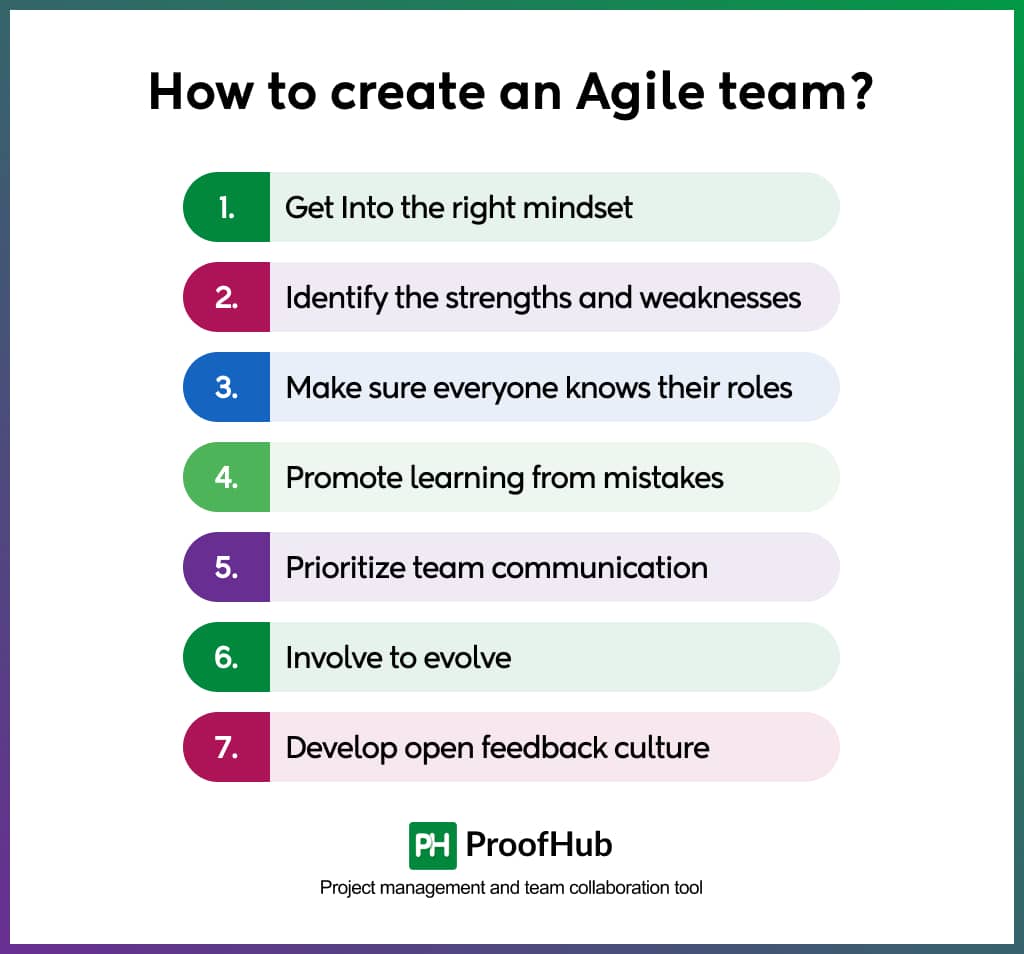
Now, I want to share some useful tips that’ll help you build a strong agile team. Here it goes:
1. Get Into the right mindset
Finding and selecting the ideal people for your agile team requires a lot of effort and patience. Creating a perfect agile team is not something that can happen overnight. Once you make up your mind to form an agile team, the first thing that you should do is to prepare yourself mentally and get into the right mindset.
You need to carefully observe the individuals already working under your command or working within your organization. It’s important that you do not let your personal preferences affect your judgment. For instance, you might have good tuning with some of the potential candidates, but you should keep such things aside and make choices solely based on an individual’s competency to fit into an agile team. Just keep in mind that agile teams are bound to have high performance and any weak links can make your team stumble during the actual run.
2. Identify the strengths and weaknesses of team members
While assessing people for your agile team, the most imperative thing that you need to keep in mind is to analyze their strengths as well as weaknesses. Moreover, you also need to examine the personalities and work styles of all the individuals whom you are eyeing as potential candidates.
The purpose of doing such research is to make sure that the professionals you are recruiting in your agile team are capable of meeting the objectives of the projects that will be assigned to them. There’s no point in assembling a team that does not have the required skills to work on projects and complete every project task efficiently. For instance, the members of an agile team must be able to adapt themselves to the new working environment and ready to tackle challenges on their way to develop projects successfully.
3. Ensure that everyone understands their roles
When members of an agile team are unclear about their roles and responsibilities for a project or in general, their productivity will go through sharp dips. So, as soon as your agile team is assembled successfully, you need to ensure that every single team member is well aware of their role and responsibilities. Usually, the roles of the members of an agile team vary by the project. However, it’s good to assign a general role for everyone on your agile team.
There are multiple benefits to having a clear understanding of roles and responsibilities. Firstly, every team member knows the exact sections of a project that he/she is accountable for. Secondly, members do not have to communicate often just to confirm whether they are supposed to get involved in a particular section of the project or not.
4. Promote learning from mistakes
An agile team brings together multiple people with different personalities and skill sets. Expecting a newly built agile team to achieve its goals in a fast-paced working environment in one shot is nothing but a deception. The people on an agile team are not expected to embrace perfectionism. Instead, learning from failures is what you need to foster in your agile team.
To put this into practice, you need to place rules and guidelines that will help your agile team to minimize risks and get more opportunities to learn from experiences. Failures indeed create a negative impact on both the organization and the morale of the team members but this is something that you need to eliminate to strengthen your team.
5. Prioritize team communication and collaboration
Communication is key to every team’s success be it an agile team or any other regular team. However, the need for effective communication can never be taken lightly for a high-performance agile team. As the project scope and requirements can have unexpected changes, members should be provided with flexible and prompt lines of communication to coordinate and modify their strategies quickly.
Ramping up communication will, to some extent, help team members to collaborate productively. However, it’s advisable to try team collaboration tips and tools that’ll help you to promote collaboration in your agile team. Remember, there’s always a high level of transparency among teams that have strong internal communication and active collaboration among members.
6. Involve to evolve
The involvement of members is essential for an agile team to be productive and deliver results on time. Whether it’s a brainstorming session to discover new ideas or a team meeting to discuss project issues, each member should participate and give their input without any hesitation.
You need to let the individuals in your agile team understand as well as feel that their opinions matters. The involvement of team members in group discussions not only brings new ideas to the table but also helps everyone to stay motivated and learn new things from each other.
7. Develop and embrace an open feedback culture
Agile teams have the responsibility to accomplish projects as quickly as possible. It simply means that you need to ascertain that all the efforts of your agile team take the project’s development in the right direction. For this, what you need is to develop an open feedback culture in your organization.
Feedback among team members makes it possible to identify and rule out problems right during a sprint. On the other hand, the feedback shared by the project owner comes handy in making the product better with every iteration. Quick and honest feedback within an agile team not only improves the quality of work but also presents new opportunities to take the project development to the next level.
Key characteristics of an Agile team
Assembling an agile team indeed demands a considerable amount of time and effort. Finding the right people from a huge pool of choices and training them to master the agile methodology is not an easy task.
This may lead you to think – why do I need an agile team? Is it worthwhile to employ an agile team for my next complex project?
Well, I will not give any direct answers to these questions. Instead, I will share some of the key characteristics of an agile team so that you better know what to expect.
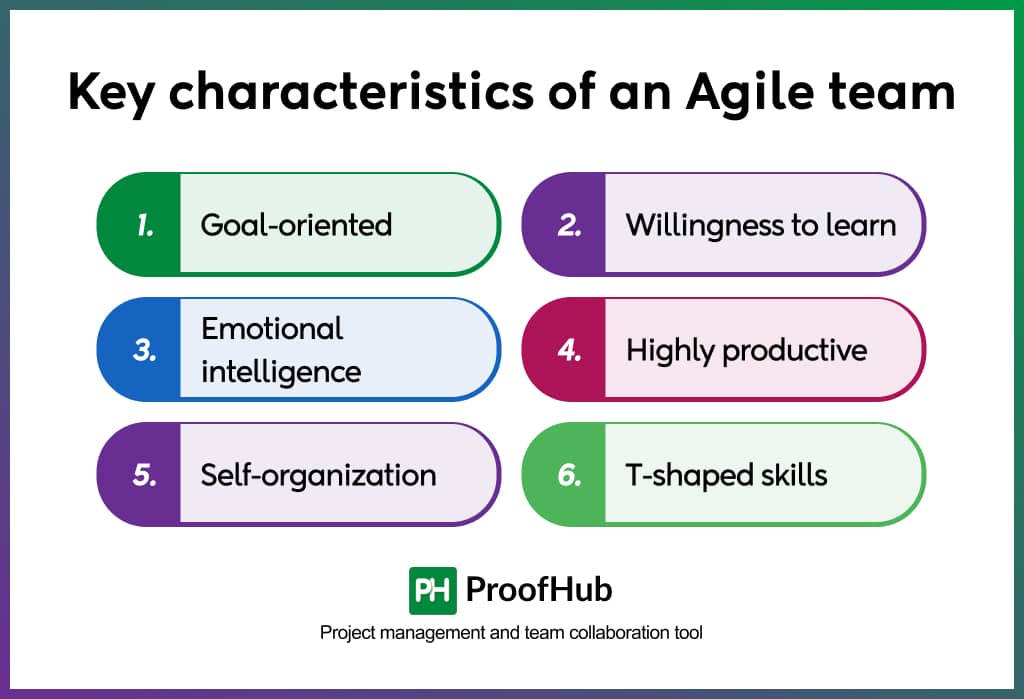
1. Goal-oriented
Being goal-oriented means that agile teams always maintain a sharp focus on their goals. At all times, they are completely aware of the goals that they need to achieve. A goal-oriented approach prompts an agile team to communicate its goals with every single person on the team. Moreover, they follow the best practices to consistently track the progress of goals.
2. Willingness to learn and improve
Learning from experiences is one of the foundation stones of an agile team. The members of an agile team welcome challenges at work so that they can learn new things and make room for continuous improvement. By enhancing their knowledge and skills, agile teams become capable of delivering quality work and accommodating the changing work environment.
3. Emotional intelligence and empathy
Agile team members are emotionally intelligent and build cordial relationships with each other. They are well aware of their emotional state and do not let their decisions or social interactions be driven by what they are feeling. Being emotionally intelligent allows them to make responsible decisions during stressful situations. At the same time, it’s easier for them to understand the emotions of the people around them and connect with them on an emotional level.
4. Highly productive
Individuals who love what they do tend to have a higher productivity level. Usually, the members of the agile team are passionate about their work, which helps them to stay motivated and full of energy. They neither procrastinate nor make excuses to save themselves from tough situations. The members of an agile team show commitment toward work and try their level best to accomplish every task assigned to them in the minimum possible time. Their high productivity levels are what separates them from the members of a regular team.
5. Self-organization
Another key characteristic that makes agile teams a better choice to work on complicated projects is their ability to self-organize. They do not need an external force to manage their work and responsibilities. Agile teams’ self-organizing capability allows them to invest more time working on project tasks rather than struggling to manage the project efficiently. Furthermore, the chances of chaotic situations to arise and prevail are quite low with agile teams taking charge of a project.
6. T-shaped skills
The members of an agile team not only possess expert knowledge and skills in a particular field but also can collaborate with professionals from other disciplines. And this is what makes them individuals with T-shaped skills. While the vertical bar of the T corresponds to deep discipline expertise, the upper horizontal bar represents cross-discipline expertise.
Manage your Agile team with ProofHub
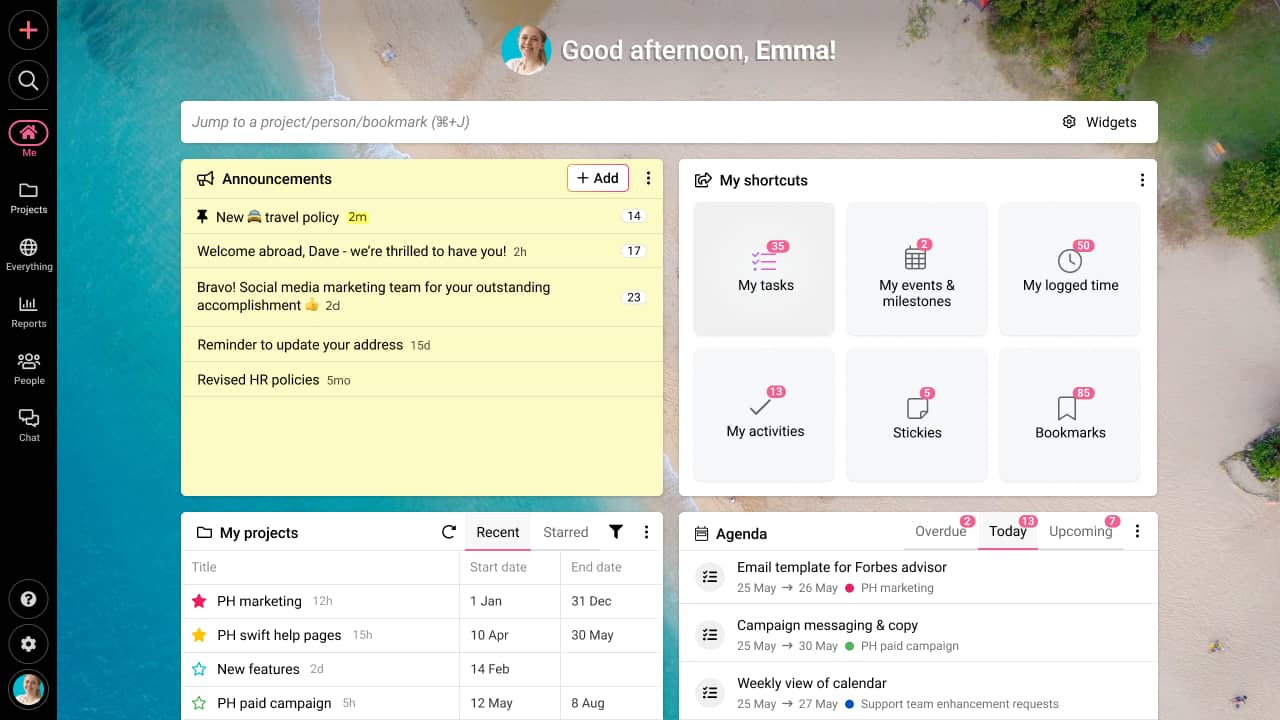
ProofHub is a project management and team collaboration software that you can use to manage your agile teams as well as complex projects. Trusted by hundreds of businesses all over the globe, ProofHub is among the top-rated project management tools. It comes loaded with a wide range of features that allow you to use it for managing projects using the agile methodology.
The software is extraordinary in the sense that it has all the essential tools that you need to plan, collaborate, organize, and deliver projects. It can streamline the project management process and assist agile teams to communicate and coordinate effectively.
Here are some of the key features of ProofHub that will come in handy for managing agile teams and projects:
1. Custom Roles
Make each member of your agile team aware of their roles in projects with ProofHub. Create and customize different roles and assign them to the members of your team with relative ease. You can also decide the access level for each role individually and control who gets to access what within a project. For an agile team working on a software development project, you can add roles such as scrum master, front-end developer, back-end developer, software tester, and so on. Additionally, you can also create separate roles for product owners and shareholders/clients and give them direct access to see all project activities.
2. Kanban Boards
Kanban boards make it possible for you to streamline the project workflow and make it easier to create iteration stages. You can create tasks, assign them to the team members, prioritize tasks, and define deadlines to put work sprints into practice. The tasks can also be seen moving through the project stages and you simply need to click a task card to view all the task details, add comments, and attach files.
Read more-: Kanban vs Agile: An In-depth comparison
3. Gantt Charts
Time is of great essence when managing a project with agile methodology. The Gantt charts in ProofHub allow you to visualize project tasks in a timeline view. It’s quite easy to plan and schedule tasks to see how individual task schedules impact the overall project timeline. The advanced Gantt charts also let you set dependencies among tasks and view the critical path of a project to finish projects within the specified time limit.
4. Custom Reports
At times, you would be required to assess the project’s progress and make changes to the project plan accordingly. With the custom reports feature in ProofHub, generating detailed project and resource reports is almost effortless. All you need is to select the parameters of your choice and highlight the desired data on project reports. Furthermore, you can create resource reports to assess the performance of your resources and visualize the distribution of resources.
5. Built-in chat app
ProofHub comes with an interactive chat app embedded right within the software’s interface to help you and your team stay connected all the time. You can start a conversation with one or multiple team members instantly over text messages. Plus, it’s possible to share files & documents over chats and make your conversations more meaningful.
6. Discussions
Each project that you manage on ProofHub comes with a dedicated discussion space where you can create different topics for discussing issues, sharing ideas, etc. Once a discussion topic is created, you need to add your team members and start communicating. Within a discussion, it’s also possible to share files and also mention people using @ to address them in the comments.
7. Online Proofing
Online proofing is one of the most useful features in ProofHub that’ll help your team to collaborate productively. By using online proofing, you can speed up the review and approval process by a great margin. You simply need to share your designs & documents with your team members and they are provided with the flexibility to review, proof, and give feedback on them in real time. Not to forget the markup tools, which allow reviewers to highlight and add actionable feedback for specific regions of the design file or document.
Conclusion
Assembling an agile team is a tedious process for sure. However, if you follow the tips that I’ve discussed above, you are most likely to face fewer hurdles and set up a high-performance agile team to handle large and complex projects.
Also, I would recommend you use software, like ProofHub, to save a significant amount of your time while dealing with agile team management.
All the best!
